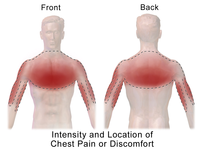
Photo from wikipedia
IN RESPONSE: Dr. Moumneh and colleagues suggest another possible explanation for the small effect on health care resources that we observed and relate it to troponin measurement for all patients… Click to show full abstract
IN RESPONSE: Dr. Moumneh and colleagues suggest another possible explanation for the small effect on health care resources that we observed and relate it to troponin measurement for all patients with chest pain, even those with a low clinical probability of acute coronary syndrome. In the data set of the HEART-Impact trial, 136 of the 1766 patients (7.7%) had a HEART score of 0 (n= 30) or 1 (n= 106); none of the 136 patients had an elevated troponin level, suggesting a small efficiency gain of these 7.7% of patients who may be discharged early from the emergency department without a troponin measurement. Taking a 2-step approach by only performing troponin testing in those with a maximum total score of 1 on the other 4 items of the HEART score might be more cost-effective, but this algorithm was not assessed in our study. Our aim was to determine the value of the HEART score in daily practice. We again stress that the HEART score is a decision tool and not a strict rule to be applied to all patients with chest pain. For example, in patients with a clear low probability, physicians may decide not to use the HEART score at all. What is crucial is the suspicion of the physician: When clinicians suspect a patient of having acute coronary syndrome, they can decide to calculate the HEART score. More important, physicians will want to measure troponin levels in every patient with suspected acute coronary syndrome for understandable safety reasons, because this measurement is so sensitive for detecting myocardial damage. Overall, the diagnostic dilemma of acute coronary syndrome is that of the balance between efficiency and safetya discussion also to be held in a broader societal context. What risk do we find acceptable in patients with chest pain when also incorporating the risk for overtreatment? Finally, the CARE score (taking a 2-step approach) that Dr. Moumneh and colleagues are testing seems interesting. We look forward to publication of their findings.
Journal Title: Annals of Internal Medicine
Year Published: 2017
Link to full text (if available)
Share on Social Media: Sign Up to like & get
recommendations!